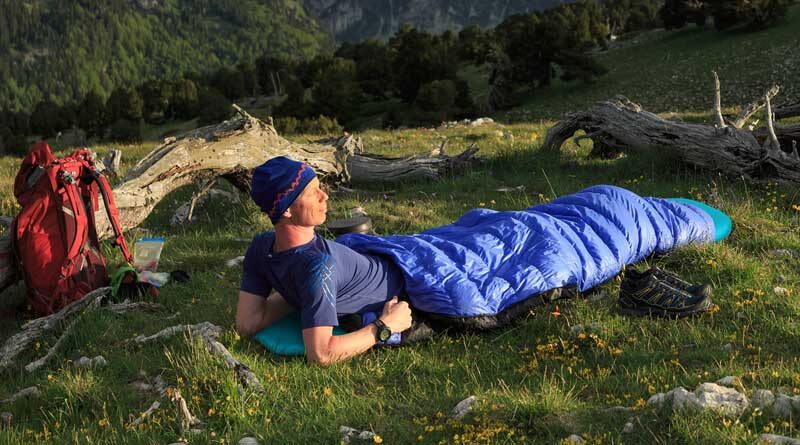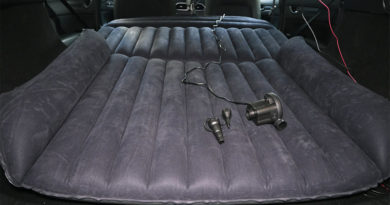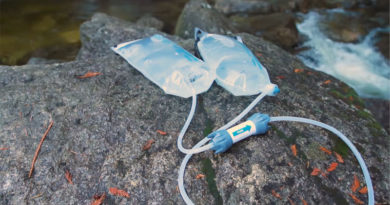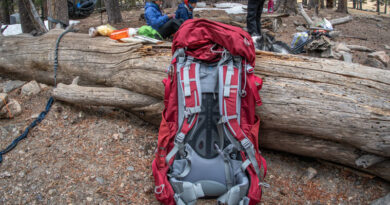Best Budget Backpacking Quilts of 2025
A backpacking quilt is essentially just like a sleeping bag so you’re going to use it at night as a cover to keep you warm in your tent. The main difference is that a quilt usually has no back to it. They’re completely open allowing your pad to act as the back of the sleeping bag and create insulation. Quilts are usually much lighter and they pack down much smaller. They have no hood like their mummy bag counterparts and a lot of backpacking quilts are convertible allowing you to open up the foot box and make it one big flat blanket so you can use it in multiple applications.
So here is the list of top budget backpacking quilts that you can purchase without breaking the bank.
1. Enlightened Equipment Revelation APEX

Weight: 1 lb. 2.77 oz.
Rated to: 40°F
Fill: CLIMASHIELD™ APEX
Dimensions: 78 x 54 x 40 in.
Pack size: 13.5 x 7 in.
The Enlightened Equipment Revelation APEX is a popular quilt for good reason. It’s light, versatile, and thoughtfully made. This quilt is perfect for active sleepers. You can open it up like a blanket on warm nights. In colder temps, you can cinch the footbox shut to stay warm. It doesn’t have a full zipper or hood, so it saves space and weight. The design works well across different climates. It’s best used with a sleeping pad for insulation underneath.
The APEX synthetic fill handles moisture better than down. It dries fast and is easy to clean. It’s not super warm on its own, though. In colder mountain weather, more layers are needed. The adjustable footbox and pad straps keep heat in and drafts out. I’ve used it in the Grand Canyon and slept amazingly well. It gave me the freedom to move and stay comfy. Yes, it’s a bit bulky, but that’s normal for synthetic quilts. It still fits in a 60L pack. For wet or humid trips, this quilt is a great choice. It’s also handmade in Minnesota, which adds a nice touch.
What I like: Lightweight and compact at resonable price.
What I don’t: Not warm enough alone for very cold mountain nights.
2. Outdoor Vitals TopQuilt

Weight: 1 lb. 2 oz.
Rated to: 30°F
Fill: 800+ fill power down
Dimensions: 75 x 31 in.
Pack size: 12.6 x 6.1 in.
The StormLoft quilt is an affordable and reliable option for backpacking and hammock camping. It weighs around just 18 ounces (regular 30°F) and it packs down super small. With the quilt inside the stuff sack, it has a diameter of 6.5 inches and a height of 11 inches. Also, if you use a compression sack, you can get it even smaller than that. If you are a hammock camper, you can use it in a hammock. Outdoor Vitals also sells an under-quilt that you can use in conjunction with this. I’m a ground sleeper so I’ve just been using it in my tent with an insulated sleeping pad. But the great thing about this quilt is that you can use it for both.
The quilt is made of a 10D ripstop nylon so it’s super lightweight and soft. The shell also has a DWR water-resistant coating so it is going to repel water. The fill is an 800 fill power down which, is also water-resistant. The StormLoft quilt has vertical baffles that run most of the way down the quilt and the foot box has horizontal baffles that run all the way around. It’s a completely enclosed sewn-in foot box. There is a drawstring so if it starts getting colder at night you can use that to cinch up around your shoulders or neck just to help seal it off, keep that heat trapped in. Also, there is a button snap at the top and there’s another button snap just a few inches below that. If you want to, you can snap this together and use it as a sleeping bag.
If you are using this in a tent with a sleeping pad, they also include a little elastic strap that is made to slip around your sleeping pad. It has those same clips on it so that you can clip the quilt down to your sleeping pad just to keep drafts down and keep the quilt from sliding around at night.
What I like: Hybrid baffle design, super compressible, DWR coating
What I don’t: The cinch cord is right in the middle so when you are trying to sleep, it rubs against your skin, which is uncomfortable.
3. REI Co-op Magma
Weight: 1 lb. 4.3 oz.
Rated to: 30°F
Fill: 850 fill power down
Dimensions: 73.2 x 50 in.
Pack size: 11.25 x 6 in.
The REI Co-op Magma 30 trail quilt is a fantastic choice for lightweight backpacking. It easily transforms from a quilt to a mummy-style bag with a simple zip and cinch. This feature makes it perfect for side sleepers like me who struggle with tight mummy bags. At 5’9″ and 240 lbs, I need extra room to move, and this quilt delivers. It contours to my body without feeling restrictive, providing both comfort and warmth. The two pad cords keep it securely in place, preventing me from sliding off my sleeping pad. The insulated draft tube around the neck and shoulders helps trap heat, making chilly nights more comfortable. The footbox can be cinched tight to block out cold air, which adds to its efficiency. Made from recycled nylon and insulated with 850-fill goose down, it is warm, durable, and environmentally friendly.
I have taken this quilt on 30 days of backcountry camping, and it has exceeded my expectations. It is lightweight, easy to pack, and surprisingly warm for its size. I have slept comfortably in temperatures down to 32°F when paired with my Big Agnes Rapide pad. If it had a hood, I believe it would handle temperatures below 30°F. The non-fluorinated DWR finish helps moisture bead up, keeping the down dry. It also comes with a stuff sack for packing and a breathable mesh bag for storage. Finding quality gear as a bigger hiker can be tough, but this quilt was a game changer. It eliminates bulk while providing freedom of movement and warmth. For anyone looking to lighten their load without sacrificing comfort, the Magma 30 is an excellent investment.
4. ENO Vesta Hammock TopQuilt
Weight: 1 lb. 12 oz.
Rated to: 30-50°F
Fill: PrimaLoft Synthetic
Dimensions: 78 x 53 in.
Pack size: 13.25 x 7 in.
The ENO Vesta Hammock TopQuilt is a well-made and lightweight option for hammock campers. It features dual-layer PrimaLoft insulation, which traps heat and eliminates cold spots. The quilt is designed for temperatures between 30–50°F when paired with a proper underquilt. A zippered footbox and adjustable draft collar let you switch between a hammock top quilt and a camp quilt. The durable water-repellent coating protects against wind and light moisture. It fits users up to 6’2″ and includes a mesh storage bag. While the quality is excellent, its performance in colder temperatures is debatable.
I tested the Vesta with my Vulcan underquilt on a four-night Boy Scouts trip. On the first three nights, with lows around 30°F, I used the Vesta inside a cheap 50-degree sleeping bag and stayed warm. On the last night, with a low of 39°F, I ditched the sleeping bag and only used the Vesta and Vulcan. Wearing thermal underwear and heavy wool socks, I still woke up cold at 4 a.m. and had to unpack my sleeping bag. The Vesta is a solid quilt, but it struggles in colder temperatures. For the price, a good sleeping bag might be a better investment. The Vulcan underquilt is essential, but the Vesta may not be worth the cost for its temperature rating.
What I like: The versatile 2-in-1 design works as both a hammock top quilt and a camp quilt.
What I don’t: Struggles to keep warm in colder temperatures below 40°F without additional insulation.
5. Therm-a-Rest Vesper

Weight: 1 lb. 5 oz.
Rated to: 20°F
Fill: 900 fill power down
Dimensions: 79 x 61 in.
Pack size: 8 x 5.5 in.
The Vesper is insulated with high-quality supremely compressible 900 fill down. While down is superior to synthetic insulation in terms of weight and compressibility, its long-standing downfall has been performance in wet conditions. Down is incredibly thermally efficient when dry but down alone won’t keep you warm if it gets wet. Therm-a-Rest accounts for this issue in the Vesper by employing a NIKWAX hydrophobic coating on the down that keeps it resistant to moisture and better suited for wet environments than traditional down insulation. The face fabric of the bag is a lightweight 10 denier ripstop nylon with a durable water repellent coating for further protection from the elements. The box baffle construction with internal mesh walls helps to keep the bag lofty and minimize cold spots.
The Vesper’s weight-saving quilt construction differs from traditional sleeping bags by eliminating the all-around coverage and zippers that add significant weight to a system. While you’ll find there’s a slight adjustment period when getting used to a quilt system, Therm-a-Rest provides some key features to make sure you stay warm and comfortable. The enclosed insulated foot box and perimeter baffles help to seal out drafts and maintain the quilt’s temperature rating. When paired with an appropriately insulated pad, this quilt is a great 3-season companion. Therm-a-Rest includes a SynergyLink connector which keeps the quilt secured on your sleeping pad to further reduce the chance of drafts.
What I like: Super lightweight, packs small, quality down, a true 32-degree option
What I don’t: Not very budget-friendly
See the Therm-a-Rest Vesper 20 See the Vesper 32
6. OneTigris Featherlite

Weight: 2 lb. 3 oz.
Rated to: 41°F
Fill: SEE Polyester
Dimensions: 78 x 33.6 in.
Pack size: 13.8 x 8 in.
OneTigris Featherlite is a top quilt designed for sleeping in hammocks. It offers synthetic fill and it weighs around 35 ounces, which is easy enough to carry in a backpack. The shell is made of 20-denier ripstop nylon with 380T polyester pongee lining and SEE polyester filling. Due to the synthetic fill, it’s not the lightest quilt out there but it’s still lighter than most sleeping bags and it also packs down reasonably small about the size of a gallon jug. The Featherlite offers relatively easy entry and exit than traditional mummy bags. There’s also a nice foot box that keeps your feet toasty all night long.
The Featherlite quilt measure around 6.5 x 2.8 feet offering enough sleeping space for an average person. The back of the quilt has a special hollowed design that is made to use with sleeping pads for better insulation and heat retention. This feature makes it a great option for those feeling claustrophobic in sleeping bags. The baffle construction is also well-designed and it provides even heat distribution throughout the quilt. The Featherlite is rated to 41°F but it can also be paired with a sleeping bag or an underquilt for even more insulation.
What I like: Provides great value for money, good quality materials, soft, and warm
What I don’t: Heavy for ultralight backpacking
7. ENO Spark
Weight: 1 lb. 9 oz.
Rated to: 40-60°F
Fill: Recycled polyester fibers
Dimensions: 78 x 53 in.
Pack size: 23.75 x 12 in.
The ENO Spark is a versatile and budget-friendly option for warm-weather camping. It works as a top quilt, camp blanket, or lightweight sleeping bag, giving you flexibility for different setups—whether you’re in a hammock, tent, or van. It’s best used between 40–60°F when paired with a proper underquilt. The dual-layer design helps keep out cold spots, and the water-repellent finish adds some protection from wind and light moisture. It fits people up to 6’2″, and for just over $100, it offers decent value without breaking the bank.
While the Spark isn’t wide enough to fully close over the shoulders for everyone, it still works well as a warm top layer. One user, around 5’8″ and 170 lbs, found it more comfortable as a blanket than as a sealed bag, especially around 55°F. The buttons and foot cinch don’t seal tightly, so you’ll want a good sleeping mat underneath in colder conditions. It’s a great choice for summer trips or as a backup option if you already own a warmer sleeping bag. Kids even liked it more than their mummy bags, thanks to its less restrictive feel.
What I like: Versatile 3-in-1 design (quilt, blanket, or sleeping bag)
What I don’t: Not wide enough to fully button over shoulders
8. SENSORY4U Ultralight TopQuilt

Weight: 1 lb. 14.4 oz.
Rated to: 32°F
Fill: 850-fill power down
Dimensions: Not specified
Pack size: 14 x 6.5 in.
The SENSORY4U Ultralight TopQuilt is a fantastic option for backpackers and campers who need warmth without extra weight. At just 1.9 lbs, it’s incredibly light, making it perfect for long hikes. Despite its lightweight design, the 850-fill power down provides excellent warmth, even in colder conditions. The foot box design adds extra comfort, allowing for natural movement without feeling restricted. The quilt also includes straps to secure it to a sleeping pad, preventing shifting during the night. It has a comfort rating of 30°F and a survival rating of 20°F, making it a solid choice for chilly nights. The weather-resistant fabric protects against moisture and wear, ensuring durability over time. Its compact size makes packing easy, saving space in your backpack. If you’re looking for a versatile, lightweight, and warm sleeping solution, this quilt is a great investment.
I tested this quilt on a cold-weather trial before my upcoming April backpacking trip to New Mexico. Temperatures dropped to the low twenties, but I stayed warm using this quilt along with down booties, ski pants, and a puffer jacket. My 5+ R-value sleeping pad and down pillow completed the setup. Unlike other expensive options, this quilt proved to be affordable and effective. It’s especially great for side and stomach sleepers since it allows more freedom of movement. No more feeling trapped or twisted up like in traditional sleeping bags. The extra ventilation also helps with temperature control. I was impressed with how well it performed and would highly recommend it for anyone looking for a cost-effective and reliable cold-weather quilt.
What I like: Great price, nice footbox, warm, and comfy
What I don’t: Average material quality
9. Sierra Designs Nitro

Weight: 1 lb. 12 oz.
Rated to: 20°F
Fill: 800-fill DriDown
Dimensions: Fits up to 6’
Pack size: 13 x 7 in.
Sierra Designs Nitro is lighter and less bulky than a traditional sleeping bag. This quilt offers water-resistant down insulation and freedom of movement. It weighs less than a pound and a half. This quilt’s design allows it to accommodate people up to 6 feet 3 inches. The quilt is insulated with 800FP PFC-Free Dridown water-resistant insulation. Down feathers have a superior ability to keep us warm but those fluffy feathers do not perform well in wet conditions. The feathers in DriDown have been coated with a hydrophobic polymer. This treated down stays dry longer in wet conditions.
Now realize that treated down can fail if it gets wet enough but it dries faster than untreated down if it does get wet. The down insulation is protected by a D ripstop polyester shell. Two insulated hand pockets allow you to wrap the quilt around your body sealing in warmth. The integrated hideaway hood is insulated to keep your head warm. There are hang-loops so you can store or dry your quilt. Each quilt includes a stuff sack and a storage bag. This quilt offers water-resistant down insulation and a built-in hood making it a great option for warm weather fast and light backpacking.
What I like: Nice built-in hood, warm, fair price
What I don’t: Heavy
Best Budget Backpacking Quilts: Comparison Table
| QUILT | WEIGHT | RATED TO | FILL | DIMENSIONS | PACK SIZE |
|---|---|---|---|---|---|
| EE Revelation APEX | 1 lb. 2.77 oz. | 40°F | CLIMASHIELD APEX | 78 x 54 x 40 in. | 13.5 x 7 in. |
| Outdoor Vitals Quilt | 1 lb. 2 oz. | 30°F | 800+ fill power down | 75 x 31 in. | 12.6 x 6.1 in. |
| REI Co-op Magma | 1 lb. 4.3 oz. | 30°F | 850 fill power down | 73.2 x 50 in. | 11.25 x 6 in. |
| ENO Vesta | 1 lb. 12 oz. | 30-50°F | PrimaLoft Synthetic | 78 x 53 in. | 13.25 x 7 in. |
| Therm-a-Rest Vesper | 1 lb. 5 oz. | 20°F | 900 fill power down | 79 x 61 in. | 8 x 5.5 in. |
| OneTigris Featherlite | 2 lb. 3 oz. | 41°F | SEE Polyester | 78 x 33.6 in. | 13.8 x 8 in. |
| ENO Spark | 1 lb. 9 oz. | 40-60°F | Polyester fibers | 78 x 53 in. | 23.75 x 12 in. |
| SENSORY4U Ultralight | 1 lb. 14.4 oz. | 32°F | 850-fill power down | Not specified | 14 x 6.5 in. |
| Sierra Designs Nitro | 1 lb. 12 oz. | 20°F | 800-fill DriDown | Fits up to 6’ | 13 x 7 in. |
Why Choose a Quilt over a Sleeping Bag?
So why would someone like you use a quilt over a sleeping bag on the trail? Well, there are a number of reasons.
Pack Size
Quilts pack down much smaller and they take up less room in your pack. They tend to weigh a lot less because there’s less material and the biggest reason for me is because I toss and turn a lot when I sleep. I feel like the quilt allows me much more room than being confined to a mummy bag.
Quilts are great for Side Sleepers
One of the main reasons I made the switch to the quilt is because I do toss and turn a lot when I’m sleeping at night on the trail. I’m a side sleeper and most of the time I sleep on my right side but throughout the night, I do turn over to my left side, back to my right, back to my left and when I was in a traditional mummy bag I always felt way too confined. I would roll around and get tangled up and then in the middle of the night, I’d get and have to unzip it and kind of correct myself and zip it back up. But with a quilt, I have much more room and the trick to that is getting a quilt that is properly sized for you.
It took me three quilts to figure out that I need a quilt that is wide and long because I move so much. Wide because if I roll over onto my side I want to make sure I’m not pulling up the sides of the quilt and letting drafts in and long because I want to make sure that if I pull the quilt over my head on a chilly night that my feet aren’t going to touch the toe box breaking that insulation barrier.
Price
Most people would say that quilts are expensive. Well, that can be true. Some company’s quilts are more expensive than others and if you are custom building a quilt and you’re doing a 950 fill, they can get quite expensive. In the long run, quilts aren’t any more expensive than some of the bigger brand mummy bags you can find on the market. If you wanted to go with a super budget option, you could go with the Outdoor Vitals 30-degree quilt.
Quilts require a Sleeping Pad
Because a quilt has no back to it, which means there’s no insulation on the underside. It requires a sleeping pad with a good R-Value to create an insulation barrier between you and the ground. For example, if you’re using a 10-degree quilt but your sleeping pad only has an R-Value of 2.6, chances are you’re probably still going to be cold on a 20-degree night. It’s not the quilt that’s making you cold, it’s the low R-Value of the pad and allowing the ground to suck the heat right out of you.
One of the most common sleeping pads I see a lot of hikers using on the trail is the Therm-A-Rest Z-Lite. It’s because you don’t have to blow it up and put it right on the top of your pack and it’s pretty easy to use. However, it only has an R-Value of 2.6. It’s great for summer camping and maybe late spring. But if you’re in those colder temps, it’s probably not going to be the best choice to use with a quilt. This all depends on what type of hiker you are and how warm you sleep. I consider myself a pretty warm sleeper and most of the time I use the Therm-A-Rest NeoAir XLite, which has an R-value of 3.2. In conclusion, if you are a foam pad user, using a quilt might not be the best for you and just sticking with a traditional sleeping bag might be a better choice.
Sleeping Pad Attachment
If it’s a very chilly night, you can simply use your pad straps. Most quilts on the market if not all come with a sleeping pad strap. When you’re using a thicker pad with a proper R-Value like the NeoAir XLite, they make pad straps that will go around your pad, and then the sides of the quilt have little buckles that attach to that strap where it will come down and create a cocoon with the quilt and the sleeping bag trapping in all that warmth at night. It’s all about cinching down the pad properly and positioning those straps to make sure that when you’re rolling, tossing, and turning at night, the quilt is not going to come up and let drafts in. Also, if it’s cinched down properly, you’re not going to roll off your pad.
Conclusion
All that being said everyone is different and everyone’s comfort levels are different. Using a quilt works for me but it doesn’t mean that it’s going to work for you. It all comes down to trying things out in the field and figuring out what’s going to be the best for you and promoting the best sleep on the trail.







